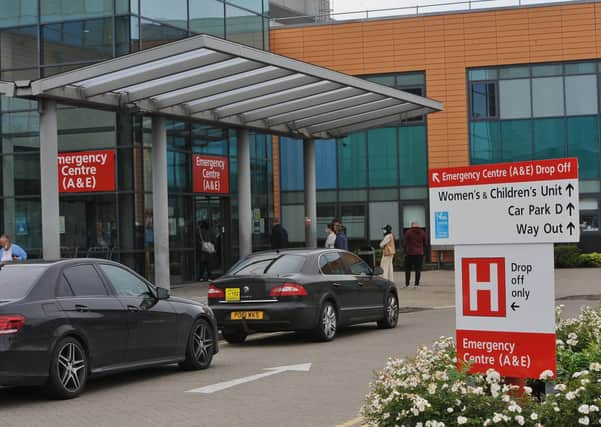Peterborough’s recently opened Urgent Treatment Centre already operating at full capacity


The Board of Governors of the North West Anglia NHS Foundation Trust (NWAFT), who are responsible for Peterborough City Hospital (PCH) have been told that the recently relocated Urgent Treatment Centre (UTC) is now working at near to its capacity.
Speaking at their meeting this week (August 18), Stacie Coburn, Deputy Chief Operating Officer NWAFT said: “When we first transferred the UTC from its city centre site to PCH there were some very long queues of people waiting to be seen.
Advertisement
Hide AdAdvertisement
Hide Ad“There were two days in July in particular when we were very challenged and our staff struggled to cope due to personnel shortages which led to us being unable to provide some pathways.
“And yes, this did contribute to a drop in our performance figures during that period which has been reflected in our report for the month of July.
“But we have addressed that situation, and I believe that our current performance figures of 86% are accurate and we will continue to improve over time.”
Duncan Lawson, Governor for Stamford and South Lincolnshire, said: “I would like to congratulate you and your team on the progress with the UTC transfer project so far; I know how badly wrong these projects can go; they rely so very much on good leadership for their success, and I suspect in this case that is you, as well as your team.
Advertisement
Hide AdAdvertisement
Hide Ad“However, I do have what I think is a fairly simple question: I’m not very good at mathematics, but you say that the average wait at UTC for Triage is 21 minutes, and the average waiting period at UTC is 2 hours and 57 minutes – then, I’m not quite sure how the ‘average performance’ figure is arrived at 86% - can you explain that?”
Ms Coburn said: “The figure is based on how many patients were seen and treated within the four hours period allotted to us for performance reference.
“So, while the initial assessment time is very important to us from a clinical standard perspective, there will be some very big discretions within that.
“As I described, in July in particular, we had some days with very big queues during the launch while patients were booking in and this has caused wild variation in the reported figures for that month.
Advertisement
Hide AdAdvertisement
Hide Ad“Everything is based on a Median figure which is why there is such a variation, and I think our performance in July was actually marred by those two days in particular, the lack of staff and inability to perform certain pathways which contributed to our drop in performance; but overall, I think the 86% figure for us was about right.”
Governor, Bob Mason, from Huntingdonshire, asked: “Do these busy times that you’ve mentioned always occur at the same time every day?”
Ms Coburn replied: “The actual answer is ‘yes’, and ‘no’, which I know is unhelpful, but that is based on certain peaks during the day from a historic perspective.
“Since we’ve relocated the UTC, we’re seeing a change in that – we were expecting a very big peak at 8am and an equally large peak in attendance at about 7pm, which is reflective of the old UTC opening hours.
Advertisement
Hide AdAdvertisement
Hide Ad“What has actually happened since we launched is that people are aware that we’re open almost 24-hours of the day because we’re now at the PCH site.
“So, the profile of attendances is changing accordingly, and what we now have is a steady flow of people who afford to wait at different times of the day, rather than queuing in the morning and queuing in the evening.
“As we begin to familiarise ourselves with demand, we can adjust our staffing levels accordingly to ensure that we have capacity coverage at the peak times of attendance.”
Governor, Sue Prior, from Huntingdonshire asked: “Can you tell me please where the Accessible Care Unit now fits into the reconfigured UTC urgent care pathway, and there is a shortage of GP-access right across the area from Huntingdonshire to Peterborough and South Cambridgeshire: is that affecting your recruitment of staff?”
Advertisement
Hide AdAdvertisement
Hide AdMs Coburn replied: “The Accessible Care Unit (ACU), is now a part of the services that we can provide through the UTC, and we’re maximising our use of the ACU with around 1200 emergency patients going through the unit in July, whereas in April that figure would’ve been around 700-800 patients per month.
“It is a key component of what we do, so that we don’t bring patients into ED or send them through the wrong pathway, or even bring them into hospital unnecessarily.
“In terms of patient primary care and GP-access, and our GP recruitment drive – we have had some success, but certainly not as much as would’ve liked.
“We’ve certainly been relying heavily on some Locum and Bank-GP-shifts to cover the UTC, and we’ve been supplementing that with some of our advanced clinical practitioners and some of our ED Doctors who equally have skills that we can use.
Advertisement
Hide AdAdvertisement
Hide Ad“We’ve had to be quite flexible in how we are providing senior clinical support in the UTC; but yes, GP recruitment is challenging and yes, there will be some patients attending who might not be able to get a GP appointment, but we are addressing the matter as best as we can, and this is not an issue unique to Peterborough by any means.”
The next meeting of the NWAFT Board of Governors in Public is Friday, 19 November 2021.